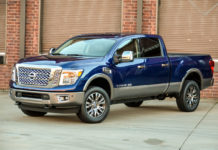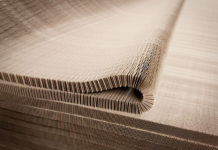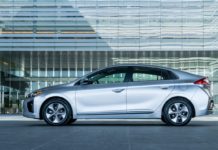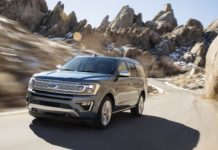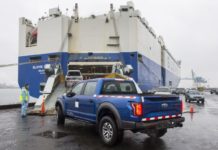The new 2008 Mercury Mariner builds on a strong foundation of offering more for the small SUV customer. It’s enhanced style and refinement is a look that will define the Mercury brand moving forward. Introduced in 2005 as Mercury’s entry-level, small SUV, Mariner built on the style and success of the mid-size four-door Mountaineer.
The original Mariner delivered a high level of design sophistication, more standard features, premium interior materials and unique content in a smartly packaged, fuel-efficient model. Now, the 2008 Mariner is completely redesigned inside and out. In addition to fresh sheet metal with new Mercury design cues and a remade interior, Mariner is updated with a comprehensive safety package, a quieter ride and more refined driving dynamics. What has not changed is the overall package: Mariner retains the fuel efficiency, maneuverability and fun-to-drive nature that is a core characteristic of the small SUV package.
The 2008 Mariner arrives as customers are increasingly looking for smaller SUVs that deliver on the attributes demanded of a traditional SUV, such as four-wheel drive, a commanding seating position, towing capability and good cargo capacity. The new Mariner continues to balance all these demands, wrapping it all in a sophisticated and stylish package that can only be found in a Mercury.
Mariner is available in Mariner, Mariner Premier and Mariner Hybrid trims. All Mariners are produced at Ford’s Kansas City Assembly Plant in Claycomo, Mo.
Clean, Modern and Sophisticated Exterior Design Sets Mariner Apart
On the outside, the 2008 Mariner’s all-new sheet metal includes significant design changes to the front/rear fascias, liftgate, headlamps and taillamps, a raised beltline, new hood and B-pillar blackout molding. There’s also a unique satin signature waterfall grille.
One striking visual statement on the 2008 Mariner is the new grille that’s larger, with bigger openings between the bars. The Mercury badge in the middle of the waterfall grille is larger, too. More brightwork front and rear gives 2008 Mariner an unmistakable Mercury presence on the road. The previous model’s body-color molding and lower body cladding are removed, giving Mariner a cleaner, more seamless profile.
Head and taillamps have a unique “eyebrow” design running around the lenses, bringing together the front and rear ends of the vehicle. Look closely: The headlamps are accentuated with a Mercury badge subtly integrated inside the housing. Taillamps have four inner lenses and a clear lamp with a red inner lens. The “powerdome” hood has a unique reverse crease that draws the eye from the grille toward the windshield.
On top of the vehicle, a new roof panel helps reduce NVH. The recessed channels on top of the vehicle are designed to improve air flow over the vehicle and reduce noise inside the cabin. Horizontal ribs in the roof also strengthen body structure and help reduce boom from wind noise.
Three new 2008 Mariner colors include Kiwi Green Clearcoat Metallic, Light Ice Blue Clearcoat Metallic and Black Pearl Slate.
Mariner’s Stylish, Sophisticated and Refined Interior Moves Further Upscale
Inside, Satin Pewter finishes and chrome accents give the 2008 Mariner an upscale look. There are new seats, door trim panels, A- and B-pillar trims, center console and a new floor-mounted shifter. The seats are monochromatic or two-tone with Alcantara ® Suede inserts.
Signaling a new direction for Mercury interior design, the 2008 Mariner is the first Mercury vehicle to debut three innovative interior features.
- A “top of dash” display positioned at eye level on the dashboard shows inside and outside temperature, radio functions and climate control readouts. When the driver or front passenger adjusts a knob or button on the instrument panel, the change is reflected in the eye-level display instead of lower down on the dashboard where information is typically located. This simple, efficient design puts much of the vehicle’s information in one place at the top of the dashboard, making it easier to read while driving.
- Ice Blue Lighting replaces green on the instrument cluster, on the center console, on the door lock and window switches and on the steering wheel. Ice Blue presents a cool, crisp, easy-on-the-eyes light for night driving and enhances the overall quality feel of the interior.
- Replacing the traditional “brick” design for the radio and heating/air conditioning controls, Mariner features dials and buttons that “poke-through” the center console. The instrument panel houses audio and climate controls, a standard MP3/iPod ® jack, controls for the heated seats and an available in-dash navigation system. The result is a more integrated, finished look.
In addition to these features, Mariner’s center console has innovative space and storage solutions. The console features best-in-class volume and two removable bins with dovetail mounting points on the front passenger side or rear of the console. The medium-sized bins can be used as a trash receptacle, an extra place to put a music player, or an additional storage space for keys, sunglasses and more.
The center console in the new Mariner is large enough to hold a laptop computer, and there are three levels of storage space. The bottom storage level features a secret compartment that goes nearly to the floor of the vehicle so Mariner owners can hide valuables like a digital camera or purse. The rear part of the console has molded-in rear-seat cupholders that are higher, sturdier and easier to reach than in the previous model.
The storage area behind the second row of seats has a newly available rear cargo management system. Lifting the rear cargo area carpet reveals a hidden, lockable place to store items – it’s a second “wet” trunk to keep snorkeling gear or wet beach towels away from dry bags or clothes. The rear cargo area carpet is also reversible – flip it over and there’s an easy-to-clean rubber surface. Mariner is one of the first Ford Motor Company vehicles to feature One-Touch Integrated Start. This feature lets the driver put the key in the ignition, turn it once and then let go – like electronic “start” buttons that are becoming common on luxury cars.
{mospagebreak}
New Steering and Chassis Upgrades Improve Mariner’s Ride and Handling
The 2008 Mercury Mariner is one of the first Ford Motor Company vehicles to use speed-sensitive Electric Power Assist Steering (EPAS), a sophisticated system that improves overall steering feel and is more efficient than conventional systems.
Conventional power steering systems use a hydraulic gear that gets power from a belt turned by the engine; this draws power and efficiency from the engine. The 2008 Mariner has seamless electric-power-assisted steering that draws power from an electric motor instead of drawing power directly from the engine accessory drive. This new system helps improve fuel economy and eliminates the hydraulic noises typical of conventional hydraulic power-assisted steering systems. Because there are no hydraulic lines or fluid, maintenance costs over the life of the vehicle are reduced, too.
A retuned suspension reinforces Mariner’s confident on-road ride. For 2008, Mariner’s car-like feel is further improved with a reduction in the rear spring rates from prior models and a front stabilizer bar that grows from 20 to 21 mm. Models with 17-inch wheels/tires get unique rear dampers and a 22-mm front stabilizer bar.
For 2008, gasoline-powered Mariners come with an all-new 10-inch, front disc/rear drum braking system that is more durable, quieter and emits less dust. The 2008 Mariner Hybrid continues with regenerative four-wheel-disc brakes.
A Focus on NVH Refinement Delivers a Quiet, Car-Like Ride
Engineers made a host of changes to the 2008 Mariner to lower NVH levels inside the vehicle.
To achieve lower NVH levels, a new acoustic windshield laminate is sandwiched between two glass panels in the front windshield. In addition to preventing the windshield from breaking apart in a collision, the new laminate material reduces the sound level of wind noise experienced in the vehicle. There’s an acoustic headliner in the vehicle as well, and the interior carpet is thicker than the previous model and does a better job of isolating noise. Overall, carpet volume has increased by 25 percent with a 50 percent increase in thickness over about 50 percent of the area.
There’s a host of other NVH enhancements, too.
- Side glass thickness has increased from 3.8 to 4.7 mm and helps prevent outside noise from entering the passenger cabin.
- On V-6-equipped models, engineers moved the alternator from the right to left side of the engine. Because the engine is transversely mounted, the noise is now located farther away from the passenger cabin.
- A new, quieter cooling fan reduces idle noise.
- All-wheel drive models have a new rear differential that is quieter and smoother.
- New windshield molding and low profile wipers help improve airflow around the vehicle and reduce wind noise.
- Redesigned recessed channels on top of Mariner are staggered and shorter to reduce boom as air flows over the top.
- Outside mirrors are larger and careful attention was given to their design to minimize wind noise.
- Additional sound deadening material has been added throughout the vehicle to reduce noise throughout the interior.
Compared with the previous model, the 2008 Mariner is 12 percent quieter on the highway (30.8 sones to 27 sones at 80 mph in the wind tunnel) and 20 percent quieter in high velocity cross winds.
Mariner’s Proven Chassis and Powertrain Reinforce Its Car-Like Ride
Mariner is tuned for the urban environment to deliver a comfortable and controlled ride. Unibody construction contributes to its light weight, nimble maneuverability, and a low stance makes it easy to get in and out of the vehicle. Responsive architecture – with four-wheel independent suspension – gives Mariner precise steering and handling and enables each wheel to react separately to road imperfections.
Mariner comes standard with front-wheel drive. An available Intelligent Four-Wheel Drive (4WD) system automatically transfers torque from front to rear as required by road conditions without driver intervention. The computer-controlled system operates so seamlessly that its engagement is barely noticeable to most drivers.
The standard engine is a 2.3-liter, 16-valve Duratec 23 4-cylinder that produces 153 horsepower at 5,800 rpm and 152 pound-feet of torque at 4,250 rpm. An optional 3.0-liter, 24-valve V-6 Duratec 30 engine produces 200 horsepower at 6,000 rpm and 193 pound-feet of torque at 4,850 rpm. Both engines come with a standard 4-speed automatic transaxle.
{mospagebreak}
Safety Canopy™ with “Roll-Fold” Technology Offers Enhanced Protection
The 2008 Mariner has, as standard safety equipment, a side-impact protection system consisting of several components: Ford’s Safety Canopy™ side air curtains that provide head and neck protection for the first- and second-row passengers, and side impact air bags that deploy out of the upper portion of the front seats to protect the upper and lower torso of the driver and passenger.
Additionally, there are occupant friendly door trims with softened armrests, side impact foam bolsters and intrusion door beams that distribute the loading during an impact to the hinge and B pillars.
Additional Mariner safety features include front seat load-limiting safety belts with dual pretensioners that, in the event of a collision, remove the slack out of the belt in two places – at the buckle and at the retractor. This cinches the driver and front passenger in their seats and allows the belts to “payout” through the ride-down of the crash event. Additionally, the driver and front passenger front air bags are new, and the energy absorbing knee bolster system of the instrument panel has been redesigned to provide better protection for both driver and front passenger.
AdvanceTrac® with RSC® Enhances Mariner’s Resistance to Rolling Over
All non-hybrid 2008 Mariner and Mariner Premier models come standard with AdvanceTrac® with RSC®, a Ford Motor Company-exclusive roll stability control and active safety system that offers a significant difference when compared to typical electronic stability control systems: It can enhance the vehicle’s resistance to rolling over.
Most systems use one gyroscopic yaw-rate sensor as they work to control yaw. AdvanceTrac® with RSC® uses a second gyroscopic roll-rate sensor to determine the vehicle’s body roll angle and roll rate. If this roll-rate sensor detects a significant roll angle, the system applies additional countermeasures – such as applying brakes to one or more wheels or reducing engine power – to enhance vehicle rollover resistance. AdvanceTrac® with RSC® is an integrated system of four major components that include:
- Anti-lock Brake System (ABS): ABS regulates brake pressure to help prevent wheel lockup when trying to stop the vehicle.
- Traction Control: When the traction control system detects a loss of adhesion between the wheels and the road surface, a computer quickly responds by reducing engine power when necessary and selectively applying brake force to the slipping wheel while transferring power to the opposite wheel.
- Yaw Control: When understeer (which leads to “pushing” wide in a turn) or oversteer (which leads to the rear end losing grip and coming around, or “fishtailing”) is detected, the system selectively applies individual brakes and modifies engine power to maximize control.
- Vehicle Roll-motion Sensor: The Ford-exclusive gyroscopic roll-rate sensor helps monitor vehicle roll motion approximately 150 times per second. If it detects a significant roll angle, it automatically engages AdvanceTrac® with RSC® to help keep all four wheels safely on the ground.
Key features and options:
Standard features include: Accessory delay; Four-wheel disc brakes; Power locks, windows and mirrors; one-touch, up/down driver window; Two 12V power points; Remote keyless entry; Driver/passenger power adjustable manual fold electric mirrors; AM/FM MP3 and satellite-ready, single-CD player with four speakers; Audio input jack; Ice Blue Lighting; Message Center; Two-way manual driver seat; Premium cloth seats; 60/40-split bench seat with premium cloth seating surfaces; Electric Power Assist Steering; Chrome exhaust tip; Privacy glass; Air conditioning; Floor mats; Side repeater lamps; Rear cargo light; 60/40-split rear seat with tip-fold-flat latch and two-way adjustable head restraints; 16-inch six-spoke wheels and all-season tires; AdvanceTrac® with RSC®; Safety Canopy™ side air curtains; Seat-mounted side air bags; LATCH; SecuriLock® passive anti-theft system; Reverse Sensing System.
Optional features include: Audiophile, 320-watt, six-disc in-dash CD changer, seven speakers, subwoofer; SIRIUS® Satellite Radio; AM/FM audio with six-disc, in-dash CD changer, four speakers; DVD-based navigation system; Premium leather seating surfaces; 17-inch satin-finish wheels; Integrated side steps; Roof rack with crossbars; Full-size spare tire; Heated Package (includes heated seats and mirrors); Amenities Package; Leather Trim Package; Moon and Tune Elite Package; Rear Cargo Convenience Package; Class II Trailer Tow Package.
Heated Package includes: Heated seats and mirrors; Redundant climate control steering wheel controls.
Mariner Milestones
| 2005 | Mercury introduces Mariner, bringing contemporary styling to the compact sport-utility vehicle segment |
| 2005 | Named a Consumers Digest Best Buy |
| 2006 | Best Compact SUV – ForbesAutos.com |
| 2006 | Named a Consumers Digest Best Buy |




